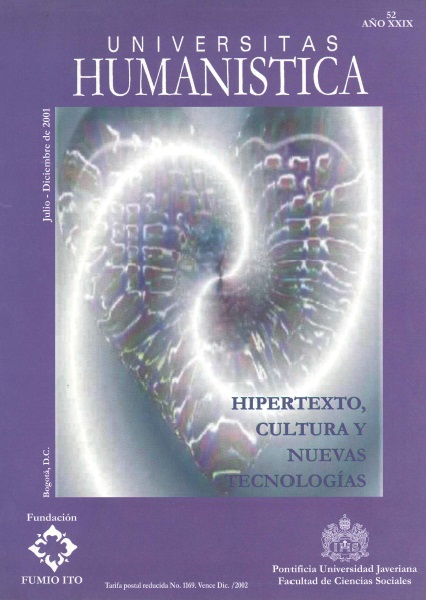Abstract
Podría hablarse de narrativa digital en múltiples sentidos: narrativa hecha con los dedos, narrativa hecha con números o dígitos, narrativa disuelta en la virtualidad electrónica. De hecho, esos tres sentidos tienen mucho que ver entre sí y con el tipo de "textos" de los que trata este artículo: los hipermedia literarios o, de otro modo, parafraseando a Susana Pajares, las posibilidades de la narrativa hipertextual. En últimas, con el término narrativa digital, se pretende contribuir a la comprensión, descripción, valoración y análisis de eso que podríamos también llamar, de acuerdo con Xavier Berenguer, narrativa interactiva: una nueva forma de narrar que se estaría configurando gracias al aprovechamiento estético de las tecnologías digitales de la comunicación y, específicamente, al uso del hipertexto, entendido, siguiendo a Landow, como una forma de textualidad digital en la que los vínculos electrónicos unen lexias, o fragmentos de textos, que pueden adoptar la forma de palabras, imágenes, sonido, vídeo, etc., promoviendo una lectura multilineal, multisecuencial o no lineal, y trasladando, así, parte del poder de los autores a los lectores.

This journal provides immediate open access to its content on the principle that making research freely available to the public, encourages greater global exchange of knowledge.
The journal Universitas Humanística is registered under a Creative Commons Attribution 4.0 International Public License. Thus, this work may be reproduced, distributed, and publicly shared in digital format, as long as the names of the authors and Pontificia Universidad Javeriana are acknowledged. Others are allowed to quote, adapt, transform, auto-archive, republish, and create based on this material, for any purpose (even commercial ones), provided the authorship is duly acknowledged, a link to the original work is provided, and it is specified if changes have been made. Pontificia Universidad Javeriana does not hold the rights of published works and the authors are solely responsible for the contents of their works; they keep the moral, intellectual, privacy, and publicity rights.
Approving the intervention of the work (review, copy-editing, translation, layout) and the following outreach, are granted through an use license and not through an assignment of rights. This means the journal and Pontificia Universidad Javeriana cannot be held responsible for any ethical malpractice by the authors. As a consequence of the protection granted by the use license, the journal is not required to publish recantations or modify information already published, unless the errata stems from the editorial management process. Publishing contents in this journal does not generate royalties for contributors.


